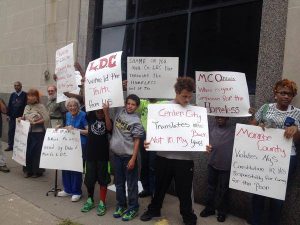
Sanctuary Village was a temporary homeless shelter, designed to provide shelter and support to chronically homeless men and women during the winter of 2014-2015. Over the course of nearly 3 months during one of the coldest winters in recent memory, Sanctuary Village sheltered more than 200 people. Sanctuary Village was an unprecedented collaboration between the House of Mercy, Buckingham Properties, and the City of Rochester. Although it opened in January 2015, the roots of the program took hold several months before.
For many years, several men and women lived in the Civic Center Garage in downtown Rochester. As the only heated garage in the City and close to several provider agencies and resources, the garage was an attractive location for the chronically homeless. Many found privacy in the nooks and crannies of the garage and outreach workers and religious groups visited the garage to provide assistance and sustenance to those staying there.
However, patrons who parked in the garage on a regular basis began to complain about sanitary and safety concerns and the LDC board that runs the garage decided to close it as a place to sleep. A cadre of homeless advocates, led by Sister Grace Miller and the House of Mercy, protested the closing of the garage until a safe and proper alternative was established. Several groups involved formed an education and advocacy group which became the Monroe County Coalition of Concerned Citizens. The group met regularly to discuss strategy, advocate for the homeless, and devise a plan to address the issue. All parties involved agreed on one thing: a parking garage is not suitable housing for anyone. The Coalition requested the garage remain open until a new location was found or individuals were placed in other shelter or housing programs. Despite these efforts, the garage was closed to the homeless in August 2014.

In October, several homeless men and women and the Coalition formed a tent city in Washington Square Park in downtown Rochester. The purpose of the tent city was two-fold:
(1) An act of nonviolent civil disobedience demonstrating the need for more housing for the chronically homeless.
(2) Provide a single, central location for those displaced by the closing of the garage and other street homeless.
Through negotiations with the City of Rochester, after three days the tent city was moved from the highly visible Washington Square Park to a more secluded location under the Fredrick Douglass-Susan B. Anthony Memorial Bridge. Both the City and homeless advocates agreed to work together to devise a more permanent solution that would provide shelter and/or housing for the chronically homeless and eliminate the need for the tent city. At this point the tent city was given a name: Sanctuary Village.

Until a more permanent solution could be created, Sanctuary Village would be a refuge and community for 30-40 homeless men and women.

I understand that this is a huge need in the community. I also understand that the coalition and other members in the community are addressing this issue. However, who can we reach out to too build a more permanent structure to assist the individuals in need? Weather this would be a combination of a grant, fund raising and or donation, there must be a way to make this happen. This would need to include all outreach, employment, and rehabilitation services. the services would need to be at will, unless a specific need was identified. Homelessness is a complex issue. To help we need to start at the Micro level with the individuals and the various social systems, while using the Macro level for the organizational and funding logistics.
I wish that the homeless community could begin to vacate vacant buildings in the city as well as suburbs, where the homeless can commit to some time there that is warm, clean, and safe for them. Meanwhile, if this vision were to take its shape in the community, one group (people who are homeless) get their needs met, while another group (citizens) not getting their needs (I mean rights–NIMBY). In writing this comment, I realize that the key to success for this “wicked problem” might be integration, not the reapplied segregation-like-band-aid that just won’t stick. Finally, I have never had a conversation with a homeless person, do they see themselves as not being homeless in their future, ever? I think the public needs to know the truth about humans who don’t have adequate protection, security, or the correct skill-set to acquire the former two needs for life. I could be way off, but want to help.